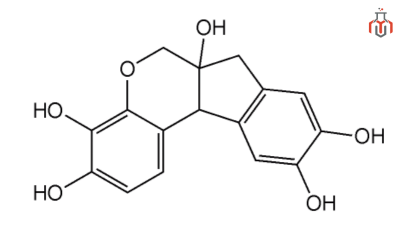

Haematoxylin or Hematoxylin is a natural basic dye extracted from the heartwood of the logwood tree Haematoxylum campechianum, primarily found in Central America. The hematoxylin name comes from the Greek words hematos (blood) and xylos (tree). It binds to negatively charged structures like DNA and RNA. It is the most widely used in medical diagnosis. In combination with Eosin Dye, it is used in H&E stain to differentiate between the nuclear and cytoplasmic parts of a cell. It occurs as white to yellowish crystals that redden upon prolonged light exposure. Hematoxylin itself is colorless, but its oxidized form, hematein, is the active colorant responsible for its staining properties.
CAS No.:517-28-2
Synonyms: Hematoxylin; Natural Black 1; Hematoxyline; Hydroxybrazilin; Hydroxybrasilin
Resources:
| Physical Properties | |
| Chemical formula | C₁₆H₁₄O₆ |
| IUPAC Name | (6aS,11bR)-7,11b-dihydro-6H-indeno[2,1-c]chromene-3,4,6a,9,10-pentol |
| Molecular weight | 302.28 g/mol |
| Solubility | Soluble in ethanol at 1 mg/mL |
| Stability | Turns Red on exposure to light; It’s solution darkens on standing |
| Chemical Properties | |
| Color | White to Yellow |
| State | Crystal or powder |
| Melting point | 212 to 248 °F (100 to 120°C) |
| Boiling Point | 579.9±50.0 °C at 760 mmHg. |
| pH | 2.4- 2.9 |
| Absorption | 400 and 700 nm |
Hematoxylin and Eosin (H&E) staining is a technique that combines Hematoxylin and Eosin dyes to differentiate between tissue types and identify abnormalities or irregularities. Hematoxylin stains acidic structures like nuclei blue, while Eosin stains basic structures like cytoplasm and extracellular matrix pink, providing contrast for histological analysis.
Slide Preparation
Hematoxylin Staining
Eosin Staining
Dehydration
Clearing
Mounting
Apply 2–3 drops of H&E Mount to the lower edge of the cover-slip, then bring the slide up to its edge.
Invert the slide gently so the mounting medium contacts the slide, then complete the inversion to secure the coverslip.
| Pictograms : |
|
| Hazard Statements : | H319: Causes serious eye irritation H317: May cause an allergic skin reaction |
| Precautionary statements : | P264: Wash face, hands, and any exposed skin thoroughly after handling P280: Wear protective gloves/protective clothing/eye protection/face protection/hearing protect P305+P351+P338: IF IN EYES: Rinse cautiously with water for several minutes. Remove contact lenses if present and easy to do – continue rinsing P337+P313: If eye irritation persists: Get medical advice/attention |
Haematoxylin or Hematoxylin is a natural basic dye extracted from the heartwood of the logwood tree Haematoxylum campechianum, primarily found in Central America. The hematoxylin name comes from the Greek words hematos (blood) and xylos (tree). It binds to negatively charged structures like DNA and RNA. It is the most widely used in medical diagnosis. In combination with Eosin Dye, it is used in H&E stain to differentiate between the nuclear and cytoplasmic parts of a cell. It occurs as white to yellowish crystals that redden upon prolonged light exposure. Hematoxylin itself is colorless, but its oxidized form, hematein, is the active colorant responsible for its staining properties.
CAS No.:517-28-2
Synonyms: Hematoxylin; Natural Black 1; Hematoxyline; Hydroxybrazilin; Hydroxybrasilin
Resources:
| Physical Properties | |
| Chemical formula | C₁₆H₁₄O₆ |
| IUPAC Name | (6aS,11bR)-7,11b-dihydro-6H-indeno[2,1-c]chromene-3,4,6a,9,10-pentol |
| Molecular weight | 302.28 g/mol |
| Solubility | Soluble in ethanol at 1 mg/mL |
| Stability | Turns Red on exposure to light; It’s solution darkens on standing |
| Chemical Properties | |
| Color | White to Yellow |
| State | Crystal or powder |
| Melting point | 212 to 248 °F (100 to 120°C) |
| Boiling Point | 579.9±50.0 °C at 760 mmHg. |
| pH | 2.4- 2.9 |
| Absorption | 400 and 700 nm |
Hematoxylin and Eosin (H&E) staining is a technique that combines Hematoxylin and Eosin dyes to differentiate between tissue types and identify abnormalities or irregularities. Hematoxylin stains acidic structures like nuclei blue, while Eosin stains basic structures like cytoplasm and extracellular matrix pink, providing contrast for histological analysis.
Slide Preparation
Hematoxylin Staining
Eosin Staining
Dehydration
Clearing
Mounting
Apply 2–3 drops of H&E Mount to the lower edge of the cover-slip, then bring the slide up to its edge.
Invert the slide gently so the mounting medium contacts the slide, then complete the inversion to secure the coverslip.
| Pictograms : |
|
| Hazard Statements : | H319: Causes serious eye irritation H317: May cause an allergic skin reaction |
| Precautionary statements : | P264: Wash face, hands, and any exposed skin thoroughly after handling P280: Wear protective gloves/protective clothing/eye protection/face protection/hearing protect P305+P351+P338: IF IN EYES: Rinse cautiously with water for several minutes. Remove contact lenses if present and easy to do – continue rinsing P337+P313: If eye irritation persists: Get medical advice/attention |
Hematoxylin, stains cell nuclei blue, whereas Eosin stains the extracellular matrix, cytoplasm, and other structures in varying shades of pink.
Hematoxylin is a colorless, crystalline solid that binds to nucleic acids in tissues. When used in histology and histopathology, it produces a deep blue-purple color, highlighting cell nuclei and other structures for microscopic examination.
Hematoxylin is a basic dye that stains acidic substances in cells and tissues a blue or blue-black color.
The Papanicolaou (Pap) stain is used for Pap smears. It includes hematoxylin, which stains the cell nuclei, and counterstains like eosin and Orange G to highlight cytoplasmic differences.
Harris’s, Mayer’s, and Gill’s hematoxylin solutions are three traditional formulas for nuclear staining.
It is based on the principle of chemical attraction between tissue & dye.
Hematoxylin in its pure powdered form is not flammable. However, many hematoxylin staining solutions contain solvents like ethanol or isopropanol, which are flammable liquids.
The most effective method for removing hematoxylin stains is using acid alcohol, a dilute solution of hydrochloric acid in ethanol (usually 70% ethanol).